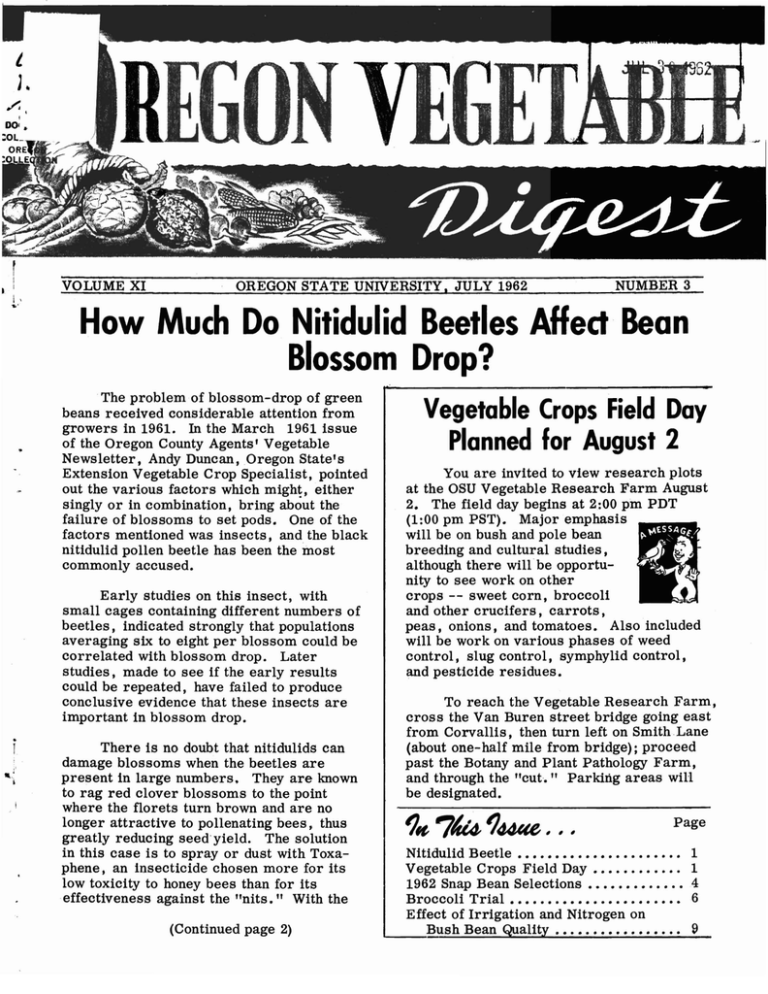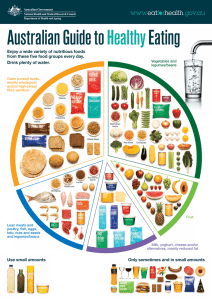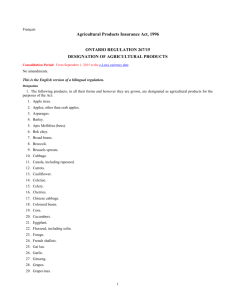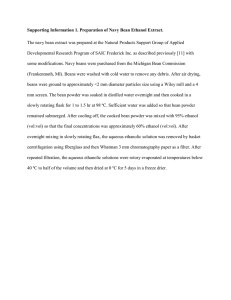Document 13797738
advertisement

t
1.
/:
.
i'
VOLUME XI
I
How Much Do Nitidulid Beetles AHed Bean
Blossom Drop?
The problem of blossom-drop of green
beans received considerable attention from
growers in 1961. In the March 1961 issue
of the Oregon County Agents' Vegetable
Newsletter, Andy Duncan, Oregon State's
Extension Vegetable Crop Specialist, pointed
out the various factors which might, either
singly or in combination, bring about the
failure of blossoms to set pods. One of the
factors mentioned was insects, and the black
nitidulid pollen beetle has been the most
commonly accused.
Early studies on this insect, with
small cages containing different numbers of
beetles, indicated strongly that populations
averaging six to eight per blossom could be
correlated with blossom drop. Later
studies, made to see if the early results
could be repeated, have failed to produce
conclusive evidence that these insects are
important in blossom drop.
j'
""
I
NUMBER 3
OREGON STATE UNIVERSITY JULY 1962
There is no doubt that nitidulids can
damage blossoms when the beetles are
present in large numbers. They are known
to rag red clover blossoms to the point
where the florets turn brown and are no
longer attractive to pollenating bees, thus
greatly reducing seed yield. The solution
in this case is to spray or dust with Toxa­
phene, an insecticide chosen more for its
low toxicity to honey bees than for its
effectiveness against the "nits." With the
(Continued page 2)
1"
Vegetable Crops Field Day
Planned for August 2
You are invited to view research plots
at the OSU Vegetable Research Farm August
2. The field day begins at 2:00 pm PDT
(1:00 pm PST). Major emphasis
will be on bush and pole bean
breeding and cultural studies,
although there will be opportu­
nity to see work on other
crops -- sweet corn, broccoli
and other crucifers, carrots,
peas, onions, and tomatoes. Also included
will be work on various phases of weed
control, slug control, symphylid control,
and pesticide residues.
To reach the Vegetable Research Farm,
cross the Van Buren street bridge going east
from Corvallis, then turn left on Smith Lane
(about one-half mile from bridge); proceed
past the Botany and Plant Pathology Farm,
and through the "cut." Parking areas will
be designated.
11e 7~ 144«e
Page
I
I
I
Nitidulid Beetle •• • • • • • • . • • • • • • . • . • . .•
Vegetable Crops Field Day •••.•.......
1962 Snap Bean Selections •..•••••..•..
Broccoli Trial
.
Effect of Irrigation and Nitrogen on
Bush Bean Quality .•.•••••.•. • • • . .•
1
1
4
6
9
2
Nitidulid Beetle . . .
(Continued from page 1)
beetle population cut down temporarily by the insecticide, the field will "color up" with
new florets and a set of seed is possible.
With beans, observations have repeatedly shown that the beetles can damage the
blossoms by feeding on the pollen and flower parts, especially if this takes place before
blossoms have opened. The problem is, "How much do nitidulids contribute to the
blossom drop which, in bush beans especially, could reduce the yield of green beans?"
The black nitidulid pollen beetle has a rather strange life history. Winter is
spent as an adult in sheltered places, such as thick moss on trees. Beetles appear
in the spring about the time wild mustard (Brassica campestris) comes into full bloom.
Pollen from these and other spring flowers is apparently a main food source. When
vetch (and to some extent clover) starts to bloom, female beetles deposit eggs in the
individual florets and then die. The legless larvae or grubs, hatcb.ing from these eggs,
feed within the flowers until mature. Strangely, this larval feeding does not seem to
harm the legume flowers or affect their ability to set pods. Pupation takes place under
debris on the surface of the ground or actually in the soil. After about 2 weeks the
adult beetle is formed and flights from vetch in fields and roadsides begin. In normal
seasons one may expect to find the first of the new generation in the flowers of various
plants about July 4. Numbers may then build up until the last week of the month, after
which the beetles start seeking hibernation quarters. Few nitidulids can be found after
mid-August. There is only one generation per year and the beetles spend about 6
months in hibernation.
Studies on the relationship between nitidulids and blossom drop must be conducted
largely during the 3-week period in July when populations are at their peak. This
period coincides with the main blooming period of green beans and the time of the year
when high temperatures are most likely to occur. In 1960 an attempt was made at the
University Vegetable Farm, in the short tirne that is annually available, to gather
information on visual stimuli which attract the flying beetles to bean plants. It was
concluded that the beetles were attracted to yellow or white surfaces in a rough ratio
to the amount of light falling on those surfaces. This type of finding might suggest
the development of beetle traps or lures.
Before .continuing research on behavior, definite establishment of the relationship
between nitidulid activity and blossom drop would seem to be in order. Cage trials
conducted in 1960 were so inconsistent that no conclusion could be drawn. Two attempts
to determine the numbers of beetles necessary to effect blossom drop in 1961 were
interesting enough {o justify a summarization here.
Cage trials involve confining different numbers of nitidulids to a bean raceme
from which all blossoms and buds have been removed--with the exception of one or two
buds judged to be within a day or so of opening. The raceme is selected and prepared;
(Contin'ued page 3)
Oregon's Vegetable Digest is published four times a year by the Agricultural Experiment Station, Ore­
gon State University, Corvallis. F. E. Price, Director. Address correspondence to the author concerned
or to the Department of Horticulture.
Material may be reprinted providing no endorsement of a commercial product is stated or ilnplied. Please credit
Oregon State University. To simplify technical terminology, trade names of products or equiplnent sOlnetitnes
will be used. No endorsement of products named is intended nor is criticism inlplied of products not mentioned.
3
Nitidulid Beetle . . .
10:
(Continued from page 2)
beetles collected in a net are counted into a small, sleeve-type, plastic screen cage; then
the cage is placed over the raceme and tied securely to its base by means of the cloth
sleeve extending from the open end. Another series of prepared racemes are tagged,
but left uncaged, as checks for comparison with field pod-set during the same period of
time. After 4 days to a week, when pod set is complete (as determined by an examination
of the uncage~ checks), the cages are removed and pod counts made.
In the first 1961 trial on bush beans, two buds were left on each raceme and 10 cages
were used for each level of nitidulid population. The results were as follows:
No. beetles per cage:
Mean no. pods set:
Percent pod set:
o
1.9
95
Field population of nitidulids
during test period:
4
1.9
95
8
1.9
95
12
1.1
55
Uncaged
1.9
95
July 13 -- 4.1 per blossom
July 21 -- 5.9 per blossom
Max. temps. during test period: 81, 84, 82 86, 86, 84, 84, and 76 0 F.
9
Assuming that the beetles in anyone cage distributed themselves about equally
on each of the two blossoms, these results again suggested that six beetles per blossom
may be the limit beyond which we might expect some blossom drop.
In the second 1961 test, bush bean racemes were stripped to only one blossom
bud each, judged to be within a day or two of opening. The results of this trial were
as follows:
No. beetles per cage:
Mean no. pods set:
Percent pod set:
4
1.0
100
Field population of nitidulids
,during test period:
6
0.9
90
8
0.9
90
10
0.9
90
Uncaged
1.0
100
July 28 -- 9.5 per blossom
July 31 -- 10.1 per blossom
Max. temps. during test period (July 28-Aug. 5): 76, 83, 85, 81, 86, 90, 92, 81, and
77 0 F.
Thus, unless our techniques are at fault, nitidulids at populations up to 10 per
blossom do not appear to be important in blossom drop. The fact that none of the
uncaged blossoms failed to set with field populations estimated at 10 beetles per
blossom (as determined by counts on 100 newly opened blossoms taken at random in
the bean planting) helps to support this conclusion.
--H. H. Crowell
Entomology Department
A •
•
4
Status of 1962 Snap Bean Selections
The following snap bean breeding material is being tested in 1962:
Advanced pole Blue Lake lines. OBU selections 284, 2244, 991, are being
tested through courtesy of several growers and processing firms in the Willamette
Valley. These lines are being increased b~r seedsmen for larger pilot tests in the
future. A replicated test of 14 lines or varieties will be run at Corvallis.
New pole Blue Lake lines. New hybri.cj combinations, followed by selection, have
been made, and apprOXimately 500 of these new lines are on trial in small Plots at the
Vegetable Research Farm, Corvallis. A shift in emphasis
to pole lines involving not only apparent yielding ability but
resistance to rust, root rot, and viruses is being made.
This will involve a.pproximately 300 additional lines in the
disease-test plot a.t Corvallis; some selections were tested in
the field in 1961, and in the greenhouse during fall and winter
of 1961~62.
To secure rf3sistance to the current strains of rust
occurring in western Oregon, it has been necessary to use
breeding material other than Blue Lake. Backcrossing to
Blue Lake pole and bush types is being done to recover
desirable pod types. Of approximately 15, 000 plants tested
for rust in the field during 1961, 280 selections were made. Correlation between field
and greenhouse rust tests has been relatively high. All rust resistant lines are being
tested for root rot resistance. Distinctly high levels of resistance to root rot (approaching
immunity) are not available in snap beans, but lines with varying tolerances are being
Selected. Some lines germinate rapidly; under certain environmental conditions they
are able to make relatively good early growth.
Advanced bush bean lines derived from Blue Lake. Several of these lines are
under 1962 pilot test by growers and processors. Beedsmen are increasing five lines
for large.r commercial plantings in 1963. None of these lines have been named or
released for uncontrolled seed increase. Progeny of the 10th backcross of Blue Lake
to bush segregates will be selected at the asu Vegetable Research Farm in 1962. It
is contemplated that this will be the last backcross.
.
At the North Willamette Experiment Station, Aurora, all advanced asu bush lines
derived from BIl:le Lake (available for pilot trial) will be grown in commercial-size
blocks, along with Tendercrop.
New bush bean lines derived from Blue Lake. The most recent single _plant
selections will be grown at Corvallis. There are approximately 400 of these lines.
New bush bean lines derived from Tendercrop and/or Puregold hybridized with
OSU bush lines. Approximately 1,500 selections (F3, F4, F5) will be grown at
Corvallis. An unusually large planting--about 10 acres--of segregating F3 progeny
involving complex crosses of Tendercrop, Puregold, and OSU Blue Lake-derived bushes
will be planted at the North Willamette Experiment Station. Approximately 150 bush
lines of complex parentage will be planted in the disease plot at Corvallis for selection
against rust, root rot, and viruses.
(Continued page 5)
5
Snap Bean Selections . . . (Continued from page 4)
"
The most promising of the new F3, F4, F5 lines will be run through preliminary
processing quality test; some expansion of this phase of the work is contemplated.
Irradiated bushes derived from Blue Lake. The R2 generation will be grown
principally at the North Willamette Experiment Station. Some selections and massed
progeny will be grown at Corvallis. The objective is to induce and find a mutation
for improved' bush habit.
Romano material. Limited numbers of selections of Romano X Blue Lake (pole
or bush) derived selections and backcrosses (to Romano) wi 11 be grown at Corvallis.
Other lines or varieties. Some new breeding lines from seedsmen (bush types)
will be grown for observation. Limited numbers of lines from Wisconsin and from the
USDA will also be grown at Corvallis. A few lines of interspecific origin (snap, runner,
lima beans) will be grown at Corvallis.
Unusually cool weather in May will likely result in relatively late maturity of
snap beans this year. Even so, it is anticipated that much of the material listed here
will be maturing from the last week in July to mid-August. Some late planted material
should be available for observation by visitors at the science meetings in late August.
Note the field day announcement in this issue of Oregon Vegetable Digest.
--w.
A. Fraz ier, J. R. Baggett,
H. J. Mack, D. L. Kleczynski,
and D. W. Davis
Department of Horticulture
--E. K. Vaughan and -Arlen Davison
Department of Botany and Plant Pathology
--We A. Sistrunk and R. F. Cain
Department of Food Science and Technology
--R. M. Bullock.
North Willamette Experiment Station, Aurora
A A A
1I~~111
August 26-31 are the dates for the joint meetings of the American Institute of
Biological Sciences and the Pacific Division of the American Association for the
Advancement of Science on the Oregon State University campus. Scientists from many
parts of the United States and Canada will be attending the national meeting of the
American Society for Horticultural Science, a member society of AIBS. Papers
will be be presented on various phases of vegetable research as well as research on
other horticultural crops in sessions scheduled for Monday thro:Igh Wednesday.
Vegetable crops sessions will be held in Cordley Hall, Room 135, morning and
afternoon, Monday, Tuesday, Wednesday, August 27 , 28, 29.
6
Results of Broccoli Trial Reported
",
Because of the current interest in uniform broccoli for more efficient harvest, a
number of the latest broccoli releases and experimental hybrids were grown forobserva­
tion and comparison with Northwest Waltham on the Vegetable Research Farm at Corvallis
in 1961. Each variety was grown in three plots, consisting of the seed plot thinned to
approximately 12 plants 24 inches apart and two transplanted plots of 12 plants, also
24 inches apart. An exception was Waltham 29, because there were only enough plants
for the seed plot•. Spartan Early was also deficient in number of plants, with the result
that no selection for transplant uniformity could be made. The number of plants for this
variety. as shown in Table 1 was low due to losses. Its performance was also affected.
Broccoli was seeded June 10 and transplanted July 10. Rows were 42 inches apart.
Approximately 400 lbs. /acre of 6-24-8 fertilizer was banded prior to planting and an
additional 500 lbs. /acre was side-dressed before heading started. Water was applieq
every 10-14 days as needed and available.
Records were taken on each plot and later compiled into a singie composite
observation for each variety. Yield figures, which are at best only approximations
because of the variability of this crop f were oJJtained by twice-weekly cutting (to 5 inch
lengths) of all usable center heads and side shoots, as· long as a given variety appeared
to produce enough to make cutting feasible. Some later varieties were still producing
some usable shoots when all cutting was terminated on October 10. Table 2 gives the
total number of plants grown and composite yields for the three plots of each variety.
It should be recognized that some of the varieties grown may not be adapted to
the same season as others. A single planting date trial would not allow evaluation of
all varieties at their full potential.
--James R. Baggett
Horticulture Department
•••
11~1ttJte" ,
Studies made in the spring of 1961 near El Centro, California, by Shadbolt,
McCoy, and Little indicate that soil temperature at I-inch depth on the top surface of
lettuce beds varied with direction of orientation. On all of the beds except that oriented
in a northwest-southeast direction, one side of the bed was 5 to 7°F. warmer than the
other. In all cases where this difference occurred, the side of the bed with a southerly
or easterly exposure was warmer. The warmest bed was that oriented in a north-south
direction, while the coolest bed was in a northeast-southwest direction. Results of the
study indicate the possibility that wind had a greater influence on soil temperature than
did the angle of the sun.
(Proc. Amer. Soc. Hort. Sci. 78:488-495. 1961.)
,I
Broccoli Trial . . .
(Continued from page 6)
Table 1. Observations of Broccoli Varieties, 1961
Variety
Source*
Florets
Unif. ** Vigor Branch Size Unif.
Gen.
color
Notes
Hybrid 62
1
3
3
4
M
3
G
Hybrid 1
2
3
5
2
S
4
p
Coastal
3
3
3
1
S-M
2
V'G
Atlantic
3
4
2
4
S
3
F-P
Quite leafy, too many leaves close to head; many
open green florets; some rosettes.
Hybrid 10
2
2
4
2
S-M
2
F-P
Few usable center heads; long heads on some, others
with high leaves; too variable in plant type; side
shoots better than center heads.
4638
2
2
4
3
S-M
3
G
Center heads quite leafy--too many high leaves; side
shoots often thin, weak, and rough.
Hybrid 60-1
4
2
2
4
S-L
3
VG
Too many small heads with coarse florets.
Spartan Early
5
3
2
2
M
2
F-P
Many bad rosettes in heads; too short to cut a normal
head without cutting down in the leafy stem; side­
shoots often too short to use.
N. W. Waltham
6
3
4
2
S-M
3
F-P
Very good producer of center heads of best general
form; a few rough and leafy; side shoots often large
and heavy; not uniform maturity; spear color some­
what light.
Waltham 29
6
3
3
3
S
4
F
Good head form and heavy side shoots; spear color
somewhat light but floret color good.
Heads much too leafy with rosettes and segmentation;
general head shape okay.
Fine florets but rough leafy heads. Too many high·
wrapper leaves; heads become very rough if past the
. very fine floret stage.
Neat plant; excellent color; some rosettes and open
florets; too short for easy cutting of a 5" head; some
bull plants.
* Sources: 1--Dessert Seed Co; 2--Ferry Morse; 3--Asgrow; 4--Burpee; 5--Michigan State University; 6--W. B.
Newburg, Birds-Eye.
**. Uniforlnity, vigor, branching, and floret uniformity scores all based on 1-5 ratings, with the highest ratings for greatest
vigor, best uniformity, etc. Floret siz,e is expressed as S-small, M-medium, or L-large.
F-fair, G-good, and VG-very good.
Color is given as P-poor,
... ­
,4
Broccoli Trial . . .
(Continued from page 7)
Table 2. Evaluation of Broccoli Varieties, 1961
Variety
No.
plants
Center heads
Av.
No.
Wt.*
wt.
Side shoots
Size
range
No.
Wt.
Av.
wt.
% Plants**
with C. H.
C. H. harvest dates***
First
Last
Hybrid 62
33
19
8*9
.47
3-6"
133
11.4
.08
58
8-12
8-29
Hybrid 1
37
26
13.9
.53
2-8
162
18.8
.12
70
8-25
9-25
Coastal
36
20
7.1
.36
3-6
159
11.8
.07
56
8-12
9-6
Atlantic
33
17
5.0
.29
3-6
278
21.2
.08
52
8-21
9-9
Hybrid 10
36
12
7.0
.58
.l
129
13.1
.10
33
8-29
10-2
4638
37
26
8.5
.33
2-52"
260
21.1
.08
70
8-21
9-19
Hybrid 60-1
33
8
2.6
.33
3-6
147
10.4
.07'
24
8-12
8-21
Spartan Early
28
19
6.2
.33
2-6
91
7.9
.09
68
8-12
9-19
N. W. Waltham 35
25
11.8
.47
2-7
211
19.6
.09
71
8-25
9-19
7
4.4
.63
2-6
61
6.7
.11
70
8-25
9-25
Waltham 29
10
2"2-7
J.
* All weights in Ibs.
** Percentage of plants producing usable center heads, disregarding size of the heads.
*** First and last dates of harvest of center heads. A portion of the total spread in harvest period is due to about
one week's difference between the seeded plot and the two transplanted plots. Varieties differed in length of this
delay period.
00
9
ERect of Irrigation and Nitrogen on
Bush Bean Quality
In recent years it has been shown that a number of things affect sloughing and
splitting of canned snap beans. In measuring differences that occurred in snap beans
grown under different conditions, it was necessary to apply a number of objective
tests to detect minor differences in quality. The tests included color, firmness,
percent seed _ percent fiber, percent sloughing, water-soluble pectin, and count of
,pollywog beans.
4'
Effect of time and amount of application of water to beans was determined in a test
on 08U-949 bush beans. The times of water application were
divided into three treatments: (1) M1 -- regular irrigation;
(2) M2 -- no irrigation until bloom, then irrigated; and
(3) M3 -- irrigation until bloom, then no irrigation. Moisture
\(
treatments were not replicated in this test. Bean yields from
~S
two nitrogen treatments at each of the moisture levels are shown
"
in Table 1. The pods of the M2 and M3 treatments were more
crooked and shorter. Percentages of seed and fiber were higher
where no water was applied after bloom. Color appeared to be
comparable in beans grown under the different conditions as
measured by the Hunter Color and Color Difference Meter.
Beans that were grown without irrigation after blooming were more susceptible
to sloughing, and cell-wall constituents were more loosely bound (Table 1). The water­
soluble pectin in the liquor of canned beans correlated with the firmness of the canned
beans although these data are not shown. There were no differences in sloughing and
water-soluble pectin due to nitrogen level. Wide differences we.re obtained between
sieve sizes 3 and 6 in color, percent seed, percent fiber, percent sloughing, and water­
soluble pectin. Sieve size 6 beans were more susceptible to sloughing, and they were
higher in water-soluble pectin.
To compare the Blue Lake type bush bean selection, OSU-949, with a standard
bush variety, Tendercrop, a test was conducted in which 1, 2, and 3 irrigations were
applied in replicated plots. This test was in cooperation with personnel of the departments
of Soils and Agricultural Engineering. OSU-949 beans were darker in color under all
irrigation levels (Table 2). In all instances, sieve size 6 beans were lighter in color
than sieve size 3 beans. Tendercrop variety had lower seed percentages in both sizes
and at the three moisture levels, although the differences were not great. At the same
time, 08U-949 was lower in fiber in both sieve sizes and at the three water levels.
Tendercrop beans were more susceptible to sloughing and splitting than 08U-949
beans under all conditions; yet the water-~oluble pectin content was lower in the
Tendercrop variety. Since the Tendercrop bean has a starchy-like taste, it was
assumed that sugars were transformed into starch instead of pectin. The shear-press
measurement of firmness indicated that Tendercrop was less firm than OSU-949 when
packed under comparable conditions. In yield and pollywog, beans, Tendercrop was
superior to the OSU-949 selection, although yield differences were not too great. It
was recognized prior to this test that the older selection of a8U -949 was subject to
crooking and pollywogs, but the newer selections from this cross have overcome much
of this weak characteristic. Shortage of irrigation water to the point where a moisture
stress was imposed tended to accentuate this weakness.
(Continued page 10)
10
Effed of Irrigation and Nitrogen . . . (Continued from page 9)
"
These two experiments emphasize the importance of adequate and proper timing of
irrigation applications when growing bush beans for canning. Obviously, increase in
pollywog beans due to moisture stress would show up in lower case pack-outs per ton.
When OSU-bush selections become available for canning, firmer canned beans with less
sloughing can be expected than are presently available from commercial bush bean varieties.
--We A. Sistrunk
Food Science and Technology Department
._- H. J. Mack
Horticulture Department
A •
'V~
1ttJte4
I
I
A
I
Wiseman, Hall, and Painter of Kansas State University reported that striped
and spotted cucumber beetles, when permitted to choose food from among a large
number 9f Cucurbit varieties, showed definite preferences for certain ones. From
this study it would appear that the muskmelon varieties Hearts of Gold and P. M.R.
4-50 may be useful as sources of resistance to the spotted beetle.
(Proc. Amer. Soc. Hort. Sci. 78:379-384. 1961.)
•••
Defoliation at the three leaf stage of development or'within three weeks of
harvest caused relatively little loss in yield of Downing Yellow Globe onions.
Defoliation at the time of maximum vegetative development and while the bulb was
enlarging up to about an inch in diameter caused the greatest reduction in yield and
bulb size. Work was done in Indiana by Baker and Wilcox to gain information on
onion yield losses caused by different amounts of defoliation and stand reductions at
different stages of plant growth.
(Proc. Amer. ~oc. Hort. Sci. 78:400-405. 1961.)
11
Effect of Irrigation and Nitrogen . . . (Continued from page 10)
Table 1.
Sieve
Hunter color
size
"Rdft
"a" "b"
Treatment
-.I
Ml--35 lhs. N
"
1
t
Effect of Irrigation Time and Nitrogen Level
on the Quality of 08U-949 Bush Beans
Ml--140 Ibs. N
"
M2--35 lbs. N
"
M2--140 lhs. N.
"
M3--35 lbs. N.
"
M3--140 lhs. N.
"
Seed
Fiber
Sloughing
W-s p~ctin
%
%
%
Mgs/100ml
3
6
8.3
8.8
0.8
0.3
11.7
13.9
8.87
.056
.085
.244
153
228
3
6
7.4
9.2
0.5
0.5
12.1
13.2
4.56
7.39
.042
.093
.205
.246
157
224
3
6
7.6
9.0
0.5
0.6
11.7
12.6
5.45
8.20
.035
.093
.218
.255
180
235
3
6
8.2
0.8
4.79
10.2
0.5
12.8
13.8
7.97
.027
.105
.218
.261
180
235
3
6
9.9
9.1
0.8
0.7
7.37
14.9
13.1 12.15
.042
.111
.233
.299
245
296
3
6
8.2
8.4
0.5
0.5
13.2
7.91
11.8 12.34
.052
.110
.256
.316
245
5~10
Ml -- Regular irrigation, June 15, 23; Jtlly 3, 13, and 20.
M2 -- Dry early until bloom; then irrigated July 3, 13, and 20.
M3 -- Wet early, irrigated June 15 and 23; then dry.
Treatment
Nitrogen
(Lbs./A)
_Yield
Tons!A
Ml
35
140
5.08
5.70
M2
35
140
5.15
5.23
M3
35
140
4.01
4.28
.207
299
12
Effed of Irrigation and Nitrogen ... (Continued from page 11)
Table 2. Effect of Irrigation Levels on the Quality of
Tendercrop and OSU-949 Bush Beans for Canning
Sieve
size
"Rd"
M2-949
949
M2- Tendercrop
Tendercrop
3
6
3
6
7.9
8.3
8.7
10.1
M3-949
949
M3-Tendercrop
Tendercrop
3
6
3
M4-949
949
M4-Tendercrop
Tendercrop
Treatment
.~
-- --- - - - - -
~
Hunter color
"b"
"a"
0.7
0.5
Seed
0.6
1.0
3.30
4.49
2.80
3.81
.0446
.0411
.0599
6
8.9
10.7
8.2
11.2
0.7
1.0
0.6
0.9
12.8
15.1
12.7
14.5
3.67
7.35
3.57
5.20
.0257
.0584
.0397
.0793
3
6
3
6
8.2
9.9
8.8
9.8
0.7
1.1
0.8
1.3
13.0
14.3
13.4
12.7
3.96
6.29
3.25
5.76
.0248
.0346
.0427
.-0704
-
~
~
~
~
~
~
~
- - --- -
~
~
~
~
~
--- - ~
size
M2-949
949
M2-Tendercrop
Tendercrop
3
6
3
6
M3-949
949
M3-Tendercrop
Tendercrop
M4-949
949
M4- Tendercrop
Tendercrop
Sloughing
.185
~
~
~
--- ­
~
Shear-press
Area under
Maximum
curve
force
(lbs. )
(lbs. )
W-S pectin
100m1
.233
.274
.436
249
283
199
227
64.0
71.2
54.4
57.6
64.0
77.6
43.2
53.6
3
6
3
6
.196
.304
.279
.438
213
240
143
231
76.8
75.2
51.2
55.2
80.0
76-.0
44.0
49.6
3
6
3
6
.218
.275
.300
.436
171
198
156
223
70.4
67.2
48.0
57.6
72.0
67.2
46.4
53.6
No. of
irrigations
Water
Inches
~
(Continued)
Sieve
Treatment
.0266
12.4
11.3
13.0
13.3
Table 2.
Treatment
Fiber
949
TC
Yield/Acre
No. pollywog beans in 2 lb. sample
949
TC
M2
1
3.2
2.77
3.04
231
127
M3
2
6.0
4.67
4.59
115
53
M4
3
7.6
5.17
6.15
90
49





